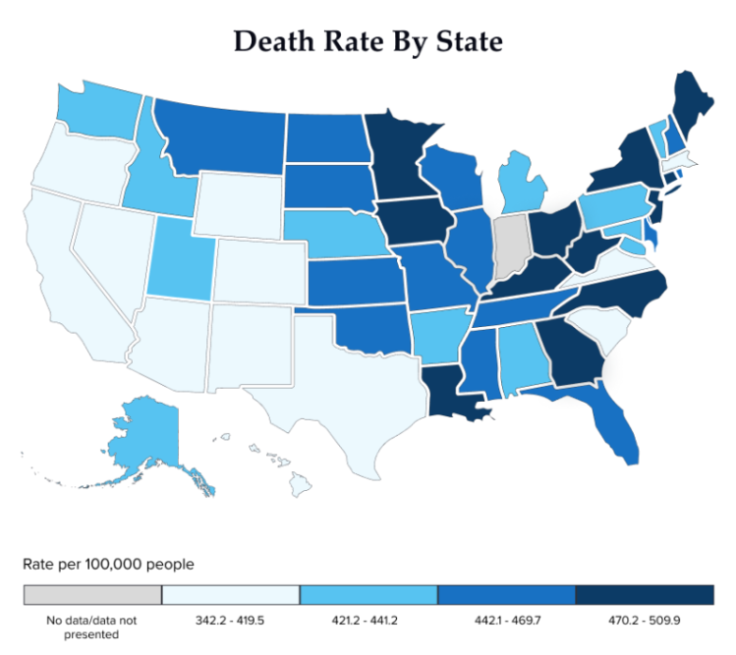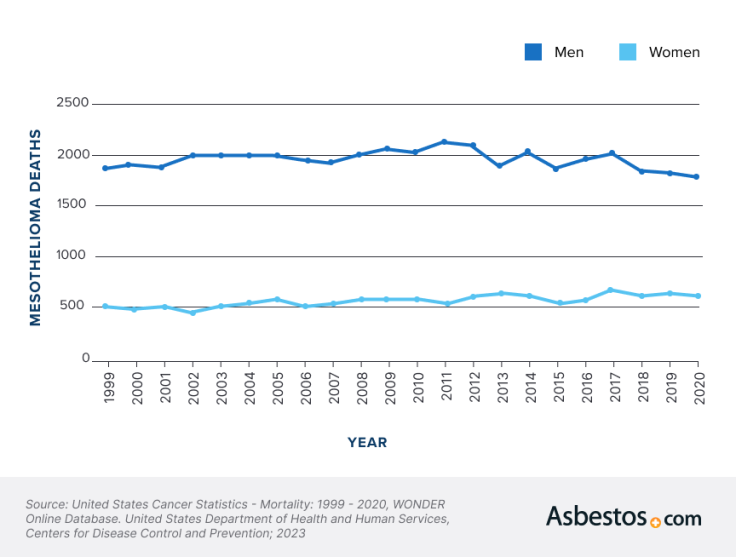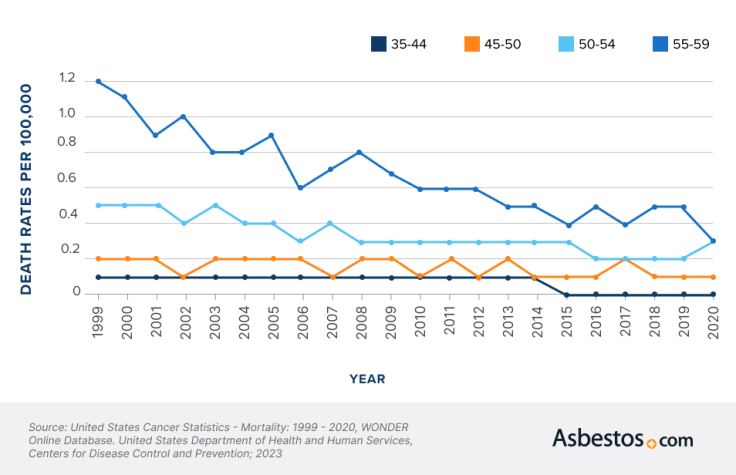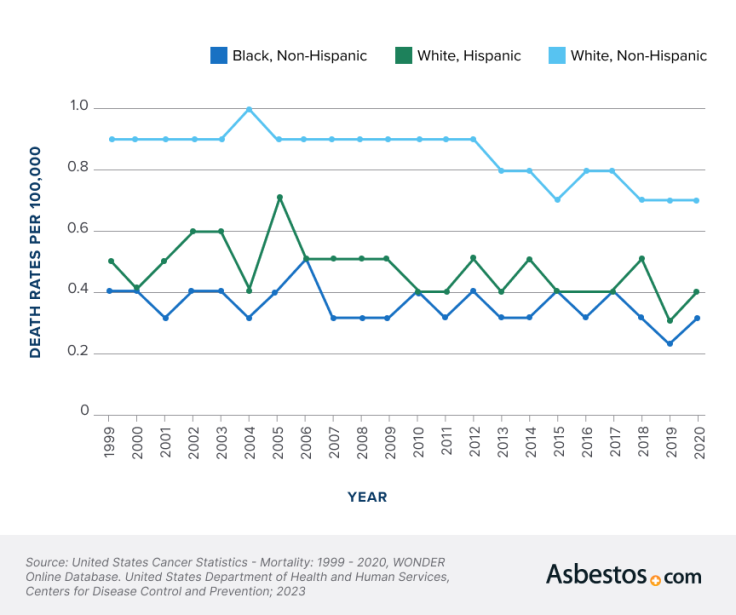
Dr. Jacques Fontaine is a thoracic surgeon at Moffitt Cancer Center in Tampa, Florida, where he heads up the Mesothelioma Research and Treatment Center. He specializes in minimally invasive robotic surgery and aggressive surgeries for mesothelioma.
The mesothelioma death rate in the United States is 1 in 100,000. Mesothelioma kills nearly 3,000 Americans each year. Among those with mesothelioma, men die at a higher rate than women. The death rate for men with mesothelioma is about 0.6 per 100,000. The mesothelioma mortality rate for women is 0.2 per 100,000.

Mesothelioma death rates show how many people die from this disease each year out of a certain number of people. These groups can be based on where people live, their age or other factors. The terms mesothelioma death rate and mesothelioma mortality rate mean the same thing. Both count deaths from any cause or from mesothelioma in those groups.
Several factors can change these numbers. For example, a person’s age, exposure to asbestos and type of treatment all affect death rates. Understanding these rates helps us see how serious mesothelioma is and why getting treatment early matters.
Learn about your diagnosis, top doctors and how to pay for treatment in our free mesothelioma guide.
Get Your GuideKey Mesothelioma Death Rate Statistics
Recent world data shows mesothelioma deaths remain high, especially in places where asbestos exposure happened in the past. The World Health Organization reports more than 30,000 deaths globally each year. About 2,500 people die from this disease every year in the United States.
Older adults who were exposed to asbestos at work decades ago have higher death rates. This information helps us see how important it is to prevent exposure and get treatment early.
The mesothelioma death rate is 1 in 100,000 in the U.S., according to the latest CDC data. A total of 2,236 people died of mesothelioma cancer in the country in 2022, per CDC statistics. Between 2018 and 2022, a total of 11,747 people died of this cancer. These numbers reflect people of all genders, ages, races and ethnicities from across the country.
Asbestos exposure plays a large role in mesothelioma death rates. Mesothelioma statistics show people exposed to asbestos are more likely to develop and die from mesothelioma. States with the most industry or natural deposits have the highest asbestos exposure and the highest mesothelioma death rates.
CDC WONDER data says mesothelioma death rates are highest in Oregon, Maine and Minnesota. Oregon has 57 deaths but the highest age-adjusted death rate of 1.1 deaths per 100,000 individuals. Maine has the second-highest age-adjusted death rate at 1.0 per 100,000. It has 19 reported mesothelioma deaths. California has the highest number of deaths at 257. But the age-adjusted rate is only 0.6 deaths per 100,000 individuals.
The highest mesothelioma death rates occur in states with known asbestos-related industries. California, Florida and Maine have shipyards that use asbestos. California and Oregon sit on some of the largest asbestos deposits in the world.

Mesothelioma death rates differ widely among demographic groups. Factors include age, gender, race and job history. Older people, especially those 65 and up, are at greater risk. A 20- to 60-year gap or latency period exists between asbestos exposure and disease onset.
Men get mesothelioma more often than women because they have traditionally worked in higher-risk jobs like construction and shipbuilding. In addition to work, where a person lives and their economic situation also affect their risk. Places with past asbestos use and limited access to healthcare usually have higher death rates.
The gap in mesothelioma death rates between men and women highlights an ongoing occupational health challenge. Although safety has improved, men still face higher risks because they have historically worked in industries with high asbestos exposure. Data from CDC WONDER shows that in 2020, the age-adjusted death rate for men was 1 per 100,000 people.
Meanwhile, recent studies indicate that although the number of mesothelioma cases among women has grown from 489 in 1999 to 614 in 2020, their age-adjusted death rate fell from 0.483 to 0.415 per 100,000 during the same time. This difference means women are less than half as likely as men to die from mesothelioma, showing how risk factors remain unevenly distributed.

Mesothelioma death rates are much higher in adults age 75 and older. People aged 85 and older have the highest crude death rate, with 7.2 deaths per 100,000 individuals. In contrast, adults ages 45 to 49 have the lowest crude death rate, at 0.1 per 100,000.
The crude death rate counts the total number of deaths in a group without adjusting for factors like age. This makes it useful for comparing death rates between different age groups because it shows the actual death risk for each group.
CDC data show that the chance of dying from mesothelioma goes up as people get older. A recent study from South Korea found that malignant mesothelioma takes about 34 years to develop after asbestos exposure. This long gap helps explain why many people only develop mesothelioma when they are older.
Mesothelioma Death Rates Per 100,000 for Ages 35 to 59:

Death Rates Per 100,000 for Ages 60 to 80+:

In 2020, CDC data show that white, non-Hispanic individuals had the highest age-adjusted mesothelioma death rate of 0.7 per 100,000 individuals. This group also accounted for the largest number of deaths, at 2,057. By comparison, Asian and Pacific Islanders accounted for only 41 deaths and an age-adjusted death rate of 0.2 per 100,000 individuals.
Studies also show Black people with mesothelioma have poorer survival rates compared to white and Asian/Pacific Islanders. The 1-year and 5-year survival rates from 2000 to 2019 for Black people are 29% and 1%, compared to 33.2% and 2.1% for white people.
Death Rates Per 100,000 by Race and Ethnicity:

Your overall health and comorbid health conditions can affect mortality rates with mesothelioma. Comorbidities, the simultaneous presence of two or more medical conditions in a patient, are other health conditions that occur alongside mesothelioma.
Other Factors That Impact Mortality
People with mesothelioma are more likely to have high blood pressure, diabetes, coronary artery disease and COPD. The CDC states that some of the leading causes of death in the U.S. are heart disease and diabetes. After a mesothelioma diagnosis, it’s vital to treat other health issues. Take care of your overall health.
Patient Advocate Dr. Snehal Smart tells us, “This rare cancer has hard numbers that can scare people. But I tell our patients and their families that there is hope. Mesothelioma specialists can help them find it. They should also use treatments and support groups.”
Mesothelioma is divided into several types, each with a unique survival rate. The median survival rate with mesothelioma is 1 year. This means that 1 year after diagnosis, 50% of individuals with mesothelioma are still alive. The 5-year survival rate for pleural mesothelioma is 12%, whereas the 5-year survival rate for peritoneal mesothelioma is 65%.
Overall, mesothelioma has a poor prognosis. But individual responses to treatment varies. One-year survival rates are about 73% for pleural mesothelioma patients and 92% for those with peritoneal mesothelioma. These differences help explain why peritoneal mesothelioma has a lower mortality rate and highlight the need for treatment tailored to the mesothelioma type.
Mesothelioma develops after a long latency period, typically 20-60 years following asbestos exposure. Many don’t show symptoms until decades after exposure. This latency makes early detection difficult.
The risk of dying from mesothelioma depends on the level of asbestos exposure. States with a history of heavy industry, such as shipbuilding and mining, tend to have higher rates of asbestos-related deaths. California, New York and Pennsylvania are among the states with elevated asbestos exposure risks.
Doctors and researchers have made progress in developing advanced mesothelioma treatments in recent years. Chemotherapy, especially when used in combination with other drugs like immunotherapy, helps people live longer and delays tumor growth. Studies show that combination chemo can extend life by about 3 months on average.
Immunotherapy helps the immune system find and destroy cancer cells. Doctors may now recommend a combination of Opdivo (nivolumab) and Yervoy (ipilimumab) as a first-line treatment. In 2024, the U.S. Food and Drug Administration approved Keytruda (pembrolizumab) with the chemo drug Alimta (pemetrexed) and platinum chemo for treating pleural mesothelioma.
Some people may benefit from newer treatments like Tumor Treating Fields. These use electrical fields to stop cancer cells from growing or dividing. The FDA has approved TTFields for treating malignant pleural mesothelioma.
Mesothelioma is an aggressive cancer, and the treatments for it can be tough. But some patients can live much longer with this treatment. The treatment combines chemotherapy, radiation and surgery. The patients who derive a benefit from this type of tough treatment and who live longer are patients who have a cell type called epithelial type or biphasic type.
More people are now aware of the risks linked to mesothelioma, especially those who were exposed to asbestos in the past. The U.S. still hasn’t fully banned asbestos, but a federal ban on chrysotile asbestos went into effect in March 2024. Experts hope this step will lower future cases and mesothelioma deaths.
Mesothelioma screenings can help doctors find the disease early, when treatment works better. Sadly, most people are diagnosed at a later stage, which limits their options. If you have a history of asbestos exposure, talk to your doctor about whether you qualify for screening.
I think that a lot of things need to be done to increase the awareness about mesothelioma and asbestos. One thing is, I believe, that it should be publicized more, just as the other cancers, such as breast cancer.
Australia, the UK and the US have the highest mesothelioma death rates. They used a lot of asbestos in construction, shipbuilding and manufacturing. Australia has the highest rate. This is due to heavy asbestos use in 20th-century mining and construction. Though bans on asbestos have reduced exposure, deaths still occur. The disease has a long latency period.
Yes, genetics can play a role in mesothelioma susceptibility. Some people may have a gene that makes them more vulnerable to asbestos fibers. Mutations in the BAP1 gene increase the risk of mesothelioma. Genetics can affect disease risk and progression. But, asbestos exposure is the main cause.
In advanced mesothelioma, patients face more pain, breathing issues and extreme fatigue. Palliative care is vital for symptom management and comfort. This includes breathing treatments, pain relief and emotional support. As the disease worsens, loved ones may see a big drop in energy, movement and awareness.
End-of-life decisions focus on comfort and quality of life. They involve choosing palliative or hospice care and managing pain. Patients may also opt for “do not resuscitate” (DNR) orders and consider wills. Seeking support is crucial for coping with mesothelioma’s final stages.
Stay up-to-date on treatment, research, clinical trials, doctors and survivors
The information on this website is proprietary and protected. It is not a substitute for professional medical advice, diagnosis or treatment. Any unauthorized or illegal use, copying or dissemination will be prosecuted. Please read our privacy policy and terms of service for more information about our website.
This website and its content may be deemed attorney advertising. Prior results do not predict a similar outcome.
The Mesothelioma Center’s claim as the most trusted resource is based on our more than 150 5-star Google and BBB reviews. Our organization also helps more than half of all mesothelioma patients annually diagnosed.
Your web browser is no longer supported by Microsoft. Update your browser for more security, speed and compatibility.
If you are looking for mesothelioma support, please contact our Patient Advocates at (855) 404-4592
The Mesothelioma Center at Asbestos.com has provided patients and their loved ones the most updated and reliable information on mesothelioma and asbestos exposure since 2006.
Our team of Patient Advocates includes a medical doctor, a registered nurse, health services administrators, veterans, VA-accredited Claims Agents, an oncology patient navigator and hospice care expert. Their combined expertise means we help any mesothelioma patient or loved one through every step of their cancer journey.
More than 30 contributors, including mesothelioma doctors, survivors, health care professionals and other experts, have peer-reviewed our website and written unique research-driven articles to ensure you get the highest-quality medical and health information.
My family has only the highest compliment for the assistance and support that we received from The Mesothelioma Center. This is a staff of compassionate and knowledgeable individuals who respect what your family is experiencing and who go the extra mile to make an unfortunate diagnosis less stressful. Information and assistance were provided by The Mesothelioma Center at no cost to our family.LashawnMesothelioma patient’s daughter


Asbestos.com. (2025, November 12). Mesothelioma Death Rate. Retrieved December 19, 2025, from https://www.asbestos.com/mesothelioma/death-rate/
"Mesothelioma Death Rate." Asbestos.com, 12 Nov 2025, https://www.asbestos.com/mesothelioma/death-rate/.
Asbestos.com. "Mesothelioma Death Rate." Last modified November 12, 2025. https://www.asbestos.com/mesothelioma/death-rate/.

Dr. Jacques Fontaine is a thoracic surgeon at Moffitt Cancer Center in Tampa, Florida, where he heads up the Mesothelioma Research and Treatment Center. He specializes in minimally invasive robotic surgery and aggressive surgeries for mesothelioma.
Our fact-checking process begins with a thorough review of all sources to ensure they are high quality. Then we cross-check the facts with original medical or scientific reports published by those sources, or we validate the facts with reputable news organizations, medical and scientific experts and other health experts. Each page includes all sources for full transparency.
Please read our editorial guidelines to learn more about our content creation and review process.
